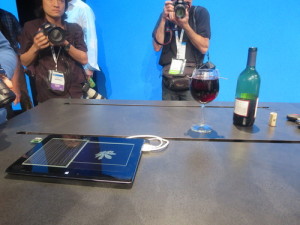In a new twist on strange brew, an Intel engineer Thursday showed off a project using wine to power a microprocessor.

The engineer poured red wine into a glass containing circuitry on two metal boards during a keynote by Genevieve Bell, Intel fellow, at the Intel Developer Forum in San Francisco. Once the red wine hit the metal, the microprocessor on a circuit board powered up. The low-power microprocessor then ran a graphics program on a computer with an e-ink display.
Further details on the offbeat technology were not available, but it is years away from practical implementation. It is just one of many projects in the works at Intel’s “New Devices” group, which is investigating business opportunities in the emerging markets of the “Internet of things” and wearable devices. Intel previously demonstrated a prototype solar chip that could be powered by a bulb’s light.
Low power doesn’t mean low performance, with Intel now thinking about microwatts, not milliwatts, said Mike Bell, vice president and general manager of the New Devices group, during an appearance at the keynote.
The goal of the demonstration was to show Intel’s progress in developing low-power chips. Bell’s group is also experimenting with a range of products such as embedded devices with sensors, smartwatches and eyewear.
“In my group, we’re like kids in a candy store,” Bell said.
The company this week introduced a line of extremely low-power processors called Quark for wearable and embedded devices, based on past chip research from Intel’s labs. Intel executives talked about how lowering chip power consumption on Quark will help it enter markets such as wearables. Such chips, which are about one-fifth the size and consume one-tenth the power of its Atom processors, could be used in eyewear and disposable medical patches that immediately send information about a patient’s vital signs to doctors.
The last day of the show over the past years was reserved for Intel CTO Justin Rattner to highlight coming technology being cooked up in Intel’s labs. Bell’s keynote was light on technological detail, and instead brought a more creative spin to Intel’s move into the mobile and embedded and wearable markets.
Future computing devices will be able to understand human behavior through data gathered by embedded sensors and other wearable technology, Bell said. Projects are also underway at Intel labs to bring a more “human element” to mobility, she said.
She provided an example of how data gathered from sensors and mobile devices could help a remote food kiosk anticipate what a customer would likely order. Another demonstration focused on bicycle safety, showing a cyclist wearing a smart jacket that sensed when the rider was braking and then flashed red lights on the jacket. The jacket is a prototype being developed by Fraunhofer Institute in Munich.
“Mobility isn’t just about the devices, but the places we visit, and also what we will do while we’re there,” Bell said.





